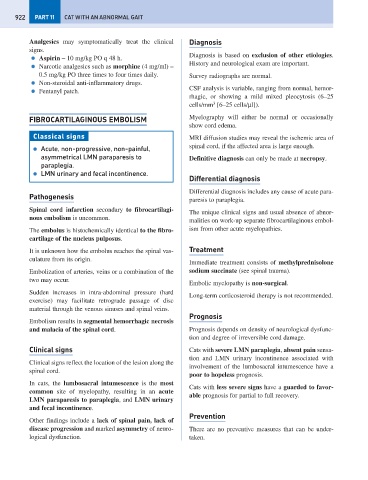Page 930 - Problem-Based Feline Medicine
P. 930
922 PART 11 CAT WITH AN ABNORMAL GAIT
Analgesics may symptomatically treat the clinical Diagnosis
signs.
Diagnosis is based on exclusion of other etiologies.
● Aspirin – 10 mg/kg PO q 48 h.
History and neurological exam are important.
● Narcotic analgesics such as morphine (4 mg/ml) –
0.5 mg/kg PO three times to four times daily. Survey radiographs are normal.
● Non-steroidal anti-inflammatory drugs.
CSF analysis is variable, ranging from normal, hemor-
● Fentanyl patch.
rhagic, or showing a mild mixed pleocytosis (6–25
cells/mm [6–25 cells/μl]).
3
Myelography will either be normal or occasionally
FIBROCARTILAGINOUS EMBOLISM
show cord edema.
Classical signs MRI diffusion studies may reveal the ischemic area of
spinal cord, if the affected area is large enough.
● Acute, non-progressive, non-painful,
asymmetrical LMN paraparesis to Definitive diagnosis can only be made at necropsy.
paraplegia.
● LMN urinary and fecal incontinence.
Differential diagnosis
Differential diagnosis includes any cause of acute para-
Pathogenesis
paresis to paraplegia.
Spinal cord infarction secondary to fibrocartilagi-
The unique clinical signs and usual absence of abnor-
nous embolism is uncommon.
malities on work-up separate fibrocartilaginous embol-
The embolus is histochemically identical to the fibro- ism from other acute myelopathies.
cartilage of the nucleus pulposus.
It is unknown how the embolus reaches the spinal vas- Treatment
culature from its origin.
Immediate treatment consists of methylprednisolone
Embolization of arteries, veins or a combination of the sodium succinate (see spinal trauma).
two may occur.
Embolic myelopathy is non-surgical.
Sudden increases in intra-abdominal pressure (hard
Long-term corticosteroid therapy is not recommended.
exercise) may facilitate retrograde passage of disc
material through the venous sinuses and spinal veins.
Prognosis
Embolism results in segmental hemorrhagic necrosis
and malacia of the spinal cord. Prognosis depends on density of neurological dysfunc-
tion and degree of irreversible cord damage.
Clinical signs Cats with severe LMN paraplegia, absent pain sensa-
tion and LMN urinary incontinence associated with
Clinical signs reflect the location of the lesion along the
involvement of the lumbosacral intumescence have a
spinal cord.
poor to hopeless prognosis.
In cats, the lumbosacral intumescence is the most
Cats with less severe signs have a guarded to favor-
common site of myelopathy, resulting in an acute
able prognosis for partial to full recovery.
LMN paraparesis to paraplegia, and LMN urinary
and fecal incontinence.
Prevention
Other findings include a lack of spinal pain, lack of
disease progression and marked asymmetry of neuro- There are no preventive measures that can be under-
logical dysfunction. taken.

